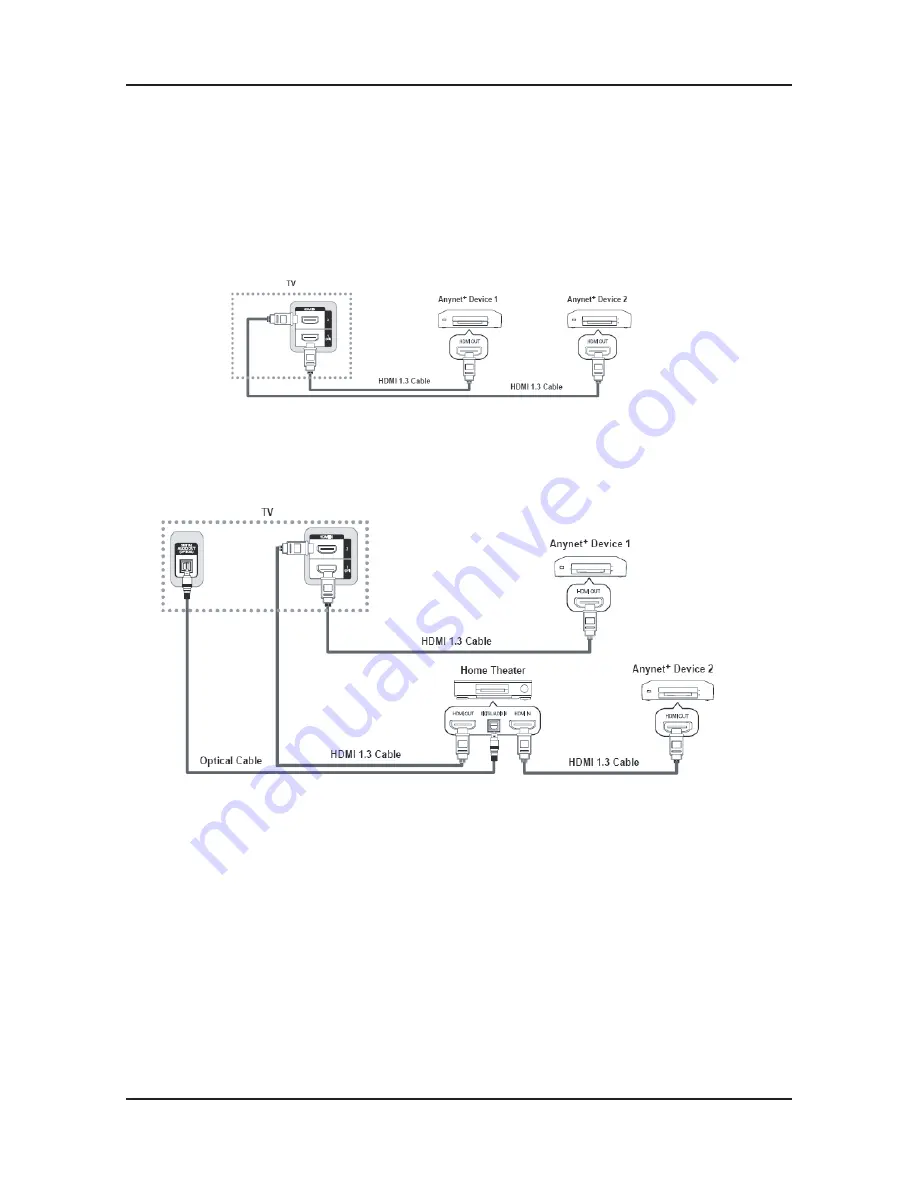
2-13
2. Product specifications
2-2. New Features explanation
2-2-1. Connecting Devices
is a function that enables you to control all connected Samsung devices that support with your
Samsung TV’s remote.
The system can be used only with Samsung devices that have the feature. To be sure your Samsung
device has this feature, check if there is an logo on it.
To connect to a TV
1. Connect the HDMI IN 1(DVI), 2 jack on the TV and the HDMI OUT jack of the corresponding device
using an HDMI cable.
To connect to Home Theater
1. Connect the HDMI IN 1(DVI), 2 jack on the TV and the HDMI OUT jack of the corresponding device
using an HDMI cable.
2. Connect the HDMI IN jack of the home theater and the HDMI OUT jack of the corresponding device
using an HDMI cable.
-
Connect the Optical cable between the DIGITAL AUDIO OUT (OPTICAL) jack on your TV and the Digital Audio
Input on the Home Theater.
-
When following the connection above, the Optical jack only outputs 2 channel audio. You will only hear sound
from the Home Theater’s Front Left and Right speakers and the subwoofer. If you want to hear 5.1 channel
audio, connect the DIGITAL AUDIO OUT (OPTICAL) jack on the DVD / Satellite Box (ie Anynet Device 1 or 2)
directly to the Amplifi er or Home Theater, not the TV.
-
Connect only one Home Theater.
-
You can connect an device using the HDMI 1.3 cable. Some HDMI cables may not support
functions.
-
works when the AV device supporting is in the Standby or On status.
-
supports up to 12 AV devices in total. Note that you can connect up to 3 devices of the same type.
Summary of Contents for UN32C5000QF
Page 57: ...4 2 4 Troubleshooting Differential Point View Top Bottom A Type B Type...
Page 61: ...4 6 4 Troubleshooting Location Main BOTTOM...
Page 62: ...4 7 4 Troubleshooting WAVEFORMS 1 PC input V sink H sink R G B 2 LVDS output...
Page 64: ...4 9 4 Troubleshooting Location Main TOP Location Main BOTTOM...
Page 65: ...4 10 4 Troubleshooting WAVEFORMS 3 HDMI input RX_Data RX_Clk 2 LVDS output...
Page 67: ...4 12 4 Troubleshooting Location Main BOTTOM...
Page 68: ...4 13 4 Troubleshooting WAVEFORMS 2 LVDS output...
Page 70: ...4 15 4 Troubleshooting Location Main BOTTOM...
Page 71: ...4 16 4 Troubleshooting WAVEFORMS 2 LVDS output...
Page 73: ...4 18 4 Troubleshooting Location Main BOTTOM...
Page 74: ...4 19 4 Troubleshooting WAVEFORMS 4 CVBS OUT Grey Bar 2 LVDS output...
Page 76: ...4 21 4 Troubleshooting Location Main BOTTOM...
Page 77: ...4 22 4 Troubleshooting WAVEFORMS 5 Compnent_Y Gray scale Pb Pr Color bar 2 LVDS output...
Page 79: ...4 24 4 Troubleshooting Location Main TOP Location Main BOTTOM...
Page 80: ...4 25 4 Troubleshooting WAVEFORMS 7 Speaker out...
Page 84: ...4 29 4 Troubleshooting Location Main BOTTOM...
Page 85: ...4 30 4 Troubleshooting WAVEFORMS 1 PC input V sink H sink R G B 2 LVDS output...
Page 87: ...4 32 4 Troubleshooting Location Main TOP Location Main BOTTOM...
Page 88: ...4 33 4 Troubleshooting WAVEFORMS 3 HDMI input RX_Data RX_Clk 2 LVDS output...
Page 90: ...4 35 4 Troubleshooting Location Main BOTTOM...
Page 91: ...4 36 4 Troubleshooting WAVEFORMS 2 LVDS output...
Page 93: ...4 38 4 Troubleshooting Location Main BOTTOM...
Page 94: ...4 39 4 Troubleshooting WAVEFORMS 2 LVDS output...
Page 96: ...4 41 4 Troubleshooting Location Main BOTTOM...
Page 97: ...4 42 4 Troubleshooting WAVEFORMS 4 CVBS OUT Grey Bar 2 LVDS output...
Page 99: ...4 44 4 Troubleshooting Location Main BOTTOM...
Page 100: ...4 45 4 Troubleshooting WAVEFORMS 5 Compnent_Y Gray scale Pb Pr Color bar 2 LVDS output...
Page 102: ...4 47 4 Troubleshooting Location Main TOP Location Main BOTTOM...
Page 103: ...4 48 4 Troubleshooting WAVEFORMS 7 Speaker out...
















































